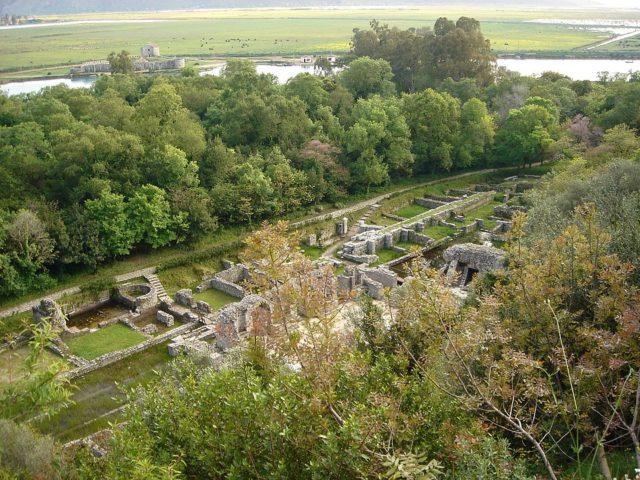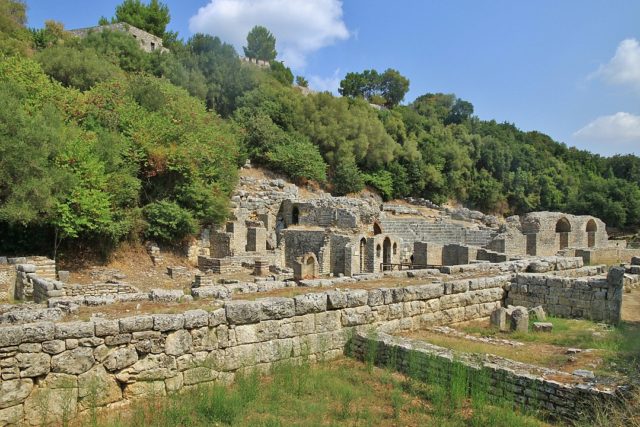The ancient city of Butrint (once known as Buthrotum) is located in the south of modern Albania, about 20 kilometers (12.5 miles) from the city of Saranda. It has been listed as a UNESCO World Heritage Site since 1992.
Over the centuries, Butrint developed into an important settlement due to its strategic position on the route from Italy to mainland Greece and its proximity to Corfu. It not only controlled trading routes but also had strong commercial agricultural interests. During the 1500s, the main commercial activities were fishing, growing olives, raising cattle, and producing timber.

The earliest archaeological evidence of settlement dates back to the period between the 10th and 8th centuries BC. The exact period of occupation is unknown since there are suggestions that the first settlement might have appeared in Butrint in the 12th century BC.
Ceramics unearthed by archaeologists suggest that there was a Greek settlement there from the 7th century BC. Evidence indicates there were temples to both Asclepius and Zeus in the city in the 5th century BC. Polygonal fortress walls from this period have also been uncovered.

It is believed that the city was able to actively develop due to donations and offerings made to the temple. With the help of such funds, many buildings were constructed during that time, including the theater and the agora (a central space for people to gather).
Around the 2nd century BC, Butrint came under the control of the Romans, and after a few years, it officially became a Roman colony. The city adopted the Latin language, established a senate, and received the right to mint coins.

Butrint expanded to almost twice its original size under Roman control. This was due to various construction projects that were implemented, such as Roman baths, a road bridge, an aqueduct over the marsh, a forum, and three shrines, including one to Minerva. Many buildings rose up around the temple of Asclepius and the theatre.
During the 1st century, the outer suburbs were developed and a typical Roman grid road system was implemented. Large private villas with decorative pools and mosaic floors were built on the outskirts of the city in the 2nd and 3rd centuries.

In the 4th century AD, many buildings were destroyed due to a strong earthquake that struck the Balkans. Despite major restorations, the architecture that had been created here over the centuries was never fully restored.
From the 5th century onwards, Christian buildings such as a large basilica, a palace, and a baptistery appeared within the city. It was around that time that Butrint became the center of the bishopric.
By the 9th century, the city was under Byzantine control and was significantly reconstructed. In the 14th century, this territory was owned by Venice. Sadly, this led to the city being destroyed once again in the 16th century due to the wars between Venice and the Ottoman Empire. However, after that, the fortifications were strengthened and expanded.
The city came under French sovereignty after the signing of a treaty between France and Austria in 1797, and two years later, the territory became part of the Ottoman Empire. Only in 1912 did Albania managed to gain independence, which resulted in Butrint being under Albanian rule.

The first archaeological excavations began in 1928 when Mussolini sent a team of Italian archeologists to the area. Although this was more a political than a scientific or cultural move, the lead archaeologist unearthed many interesting finds. Excavations continued until World War II, by which time the Hellenistic and Roman parts of the city had been uncovered, including the Lion Gate and the Scaean Gate.
In 1944, Albanian President Enver Hoxha banned foreign archaeological missions in his country, and only Albanian archaeologists were allowed on the site. In the 1970s, the Albanian Institute of Archeology began larger excavations in the city.

After President Hoxha passed away in 1992, the Communist regime ended, and Butrint was included on the UNESCO World Heritage List that same year. However, the new democratic government had big plans for the remains of the city, including developing it into an airport, and the city was moved onto the List of World Heritage in Danger. It was also subject to looting and a lack of care.
During this turbulent time, archaeological excavations nevertheless continued, leading to Roman villas and a Christian church being discovered at the end of the 20th century.

In 2000, the area around Butrint was declared a national park. The protected site kept being expanded until it reached an area covering 94.24 square kilometers (36.39 square miles) in 2005, at which point it was removed from the World Heritage Sites in Danger list. The terrain includes freshwater lakes, wetlands, and salt marshes.
The park is now administered by the Ministry of Environment of Albania, and the ancient city has become a popular tourist destination, with many people visiting from the nearby island of Corfu and Saranda.

The most interesting monument from ancient Greece is the well-preserved theater. There are plenty of inscriptions on the stones, giving details of slaves who’ve been freed as well as more information about the city during the Hellenistic period. From the Christian era, the baptistery (an ancient Roman building that was converted) stands out as the most notable due to its mosaic floors.
A big draw from the Roman era is the Lion Gate, which was one of six entrances into the city during the 4th century BC. It was named “the Lion Gate” because it has a carving of a lion eating a bull. The lion represents the city of Butrint while the bull represents enemies of the city.

The Butrint World Heritage Site is considered to be well preserved as it hasn’t suffered from neglect or urban development over the years. However, it is susceptible to the seasonal rise in water levels, vegetation growth, and the structural instability of some monuments. In addition, road and city developments in the area are putting pressure on this historic site.
The city of Butrint is considered one of the most important archaeological sites in Albania. It is seen as unique because it’s an area that combines both archaeological and cultural heritage with nature and complex ecosystems.

Another Article From Us: Abandoned Water Park – Ho Thuy Tien, Vietnam

